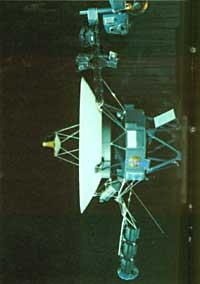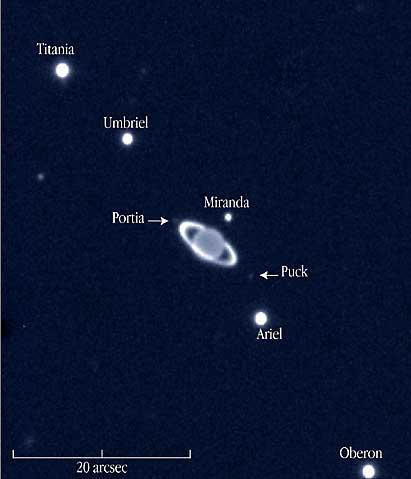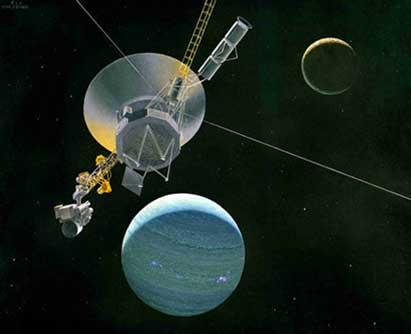Passengers without borders
2002/12/01 Carton Virto, Eider - Elhuyar Zientzia Iturria: Elhuyar aldizkaria
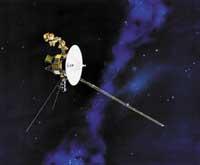
The Voyager were the continuation of NASA's Pioneer 10 and Pioneer 11 missions. Pioneers reached the planets beyond Mars in 1972 and 1973 and travelers in 1977. It was not any brand, far away, because they are far away.
If we look at the distances, Mercury, Venus and Mars can be considered neighbors of the Earth, 92, 42 and 98 million kilometers. But the next planet, Jupiter, lives in the neighbouring neighborhood. From Earth to Jupiter there are 647 million kilometers and to Saturn 1.343. Time, however, allowed great actions.
Golden Decade of Planetary ExplorersPioneer
The Voyager era was gold in the exploration, political and scientific of the planets. Soviet and American competition was intense and governments were willing to invest money in a single project. In the 1950s, both of them explored the Moon, in the 1960s they reached Venus and Mars, and in the 1970s they wanted to go even further. In addition, NASA's Apollo XI had just won the first man in the Moon race.
According to Carl Sagan, astronomer and writer, the United States explored the solar system by the existence of the Apollo program. Although the main objectives of the Apollo program were not scientific, they made scientific contributions and, above all, provided Americans with illusion and leadership for the future.
One of the scientific advances achieved along with optimism was that of NASA's Marineer 10 vessel. Marineer 10 demonstrated the utility of gravity assist and reduced travel time to Neptune from 30 to 12 years. In short, this technique takes advantage of the gravitational force of the planets to change the trajectory and speed of the spacecraft.
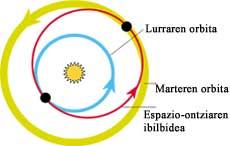
Interplanetary journeys are not made in a straight line but forming orbits around them. These orbits are designed to depend on one point of the gravitation of planet A and another of planet B, so that spacecraft can travel from Earth to Mars, from Mars to Jupiter, from Jupiter... spending little fuel. As they approach each of the planets, gravitational interactions accelerate the spacecraft and direct it to the next planets. Without this navigation system, spacecraft would have much more fuel and weight and their launch would be even more expensive.
Another exciting event was that of the Pioneer ships, which suffered the huge magnetic field of Jupiter without deteriorating. And at that time when the knowledge of the planets was growing, something that was not in man's hands was about to happen: Jupiter, Saturn, Uranus and Neptune line up in the following years in the late 1970s.
These planets need between 12 and 165 years to complete a tour around the Sun and are rarely all on the same side of the star and close, specifically every 175 years. If it was not done then some generations would have to be expected to travel simultaneously to all planets using the gravity assist technique. NASA did not want to miss the opportunity and accepted the Voyager mission.
However, they considered that the trip to visit the four planets was too expensive and decided to limit Voyager's mission to Jupiter and Saturn to give continuity to the work done by Pioneer. Among the 10,000 possible routes were chosen Jupiter and its satellite Io and Saturn and its satellite Titan, but not all doors were closed, as the route of Voyager 2 allowed the displacement to Uranus and Neptune.
Thus, in 1977, the twin Voyager packages departed. Two years later they came to Jupiter and in 1980 and 81 to Saturn. But the trip did not end in Saturn.
After Saturn's research, Voyager 1 went ahead above the plane of the Ecliptic, in which most of the planets in the solar system orbit, and Voyager 2 surprised the project managers with an unbeatable surprise. He had all the work tools in good condition and could reach Uranus.
NASA decided to extend the mission and Voyager came not only to Uranus, but also to Neptune in the years 2, 1986 and 1989, respectively. Then, as the twin did, he continued out of the ecliptic plane, in this case down. In total, NASA spent $865 million on the project.
Unprecedented satellites, rings...
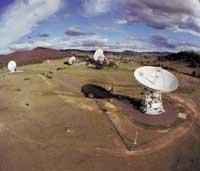
Voyager
the ships have emitted five billion bits of data to the Earth, 6,000 encyclopedias sufficient to encode the Britannica and 11,000 years of dedication. Only 50,000 photographs of the Jupiter system. In fact, almost everything was to be discovered with the gaseous giants.
For example, it was known that all giant planets had rings that once characterized Saturn. Before the Voyager reached Jupiter, astronomers discovered the rings of Uranus and discovered something around Neptune, but Voyager confirmed them and demonstrated that they were all different.
In addition to the rings, 23 satellites were found: 3 of Jupiter, 4 of Saturn, 10 of Uranus and 6 of Neptune, knowing more the already known. In the satellite Io of Jupiter were found the only active volcanoes located outside the Earth, 100 times more active than those here. It was known that Europe, another satellite of Jupiter, was a world covered with ice, and that perhaps there was liquid water below.
These discoveries in the jupiter system have given way to other missions. Next year, NASA will destroy the Galileo spacecraft, which for seven years has been investigating Jupiter and its moons. Among other things, Galileo has confirmed that under the ice surface of Europe there may be an ocean of salt water and NASA is thinking of more closely analyzing this satellite, despite the fact that the Europa Orbiter project has been suspended due to budget restrictions.
Since 1997, the Cassini-Huygens ship is headed to Saturn. It will arrive in 2004 and the part called Cassini will orbit the planet and its satellites for four years. The Huygens section lands on the Titans. Of the solar system satellites, Titan is the only one with atmosphere and space agencies in Europe and the United States want to analyze it closely. Do not forget that the possibility of finding life outside of planet Earth is never lost sight of when promoting such missions. Both live on public money and life is a sweet sweet sweet.
Precisely thanks to the Voyager mission it was discovered that Titan has a thick atmosphere of nitrogen. At the same time, they highlighted the rich geology of Saturn's satellites: the giant craters, the cliffs..., against what was thought, were not frozen inert worlds. From the hand of the Voyager ships it was also discovered that Saturn, Uranus and Neptune have magnetic field — until 1977 Jupiter was the only gas giant with this characteristic. And more.
Voyager
Ellis D, who worked on the mission. Researcher Miner has recently stated that these missions revolutionized the research of distant planets “because they brought research topics from the field of astronomy to those of geology, climatology, etc.”
Voyager Interstellar mission
After investigating Jupiter, Saturn, Uranus and Neptune, each has followed their journey separately. Right now, travelers are at the limits of the solar system, twice as far as Pluto. The first runs 520 million kilometers a year and the second 470. This means that if you could move the Voyager as fast as 1, just count from 1 to 3 would make 52 kilometers, as it runs 17.3 kilometers per second.
Moved at that speed, it is no wonder that the human being is, sometimes, the object that has farther emitted. But, above records, the Voyager have a scientific role in the limits of the solar system: They must study the boundary between the zone of solar influence, the heliopause, and the broad universe.
In the next ten years they will reach the limits of the frost, 5-14 million kilometers from the Sun, crossing a space called termination shock. There, the speed of particles emitted by the Sun goes down to the room and sudden changes occur in the environment. An increase in free space is expected in another 10-20 years.
Astronomers know very little about this area and are eager to collect Voyager data. They don't seem to be wanting, as they have enough energy to keep working until at least 2020. They will then stop sending information but not travel. They will continue on the path of the stars to the limit.
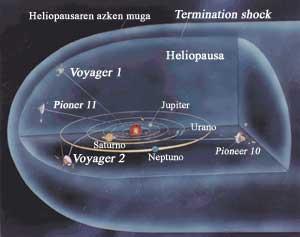
A message across the border
Voyager
the ships, like the Pioneers, will always travel or continue to travel through space and Carl Sagan did not want to miss that opportunity to send a message along with the Voyager to the other inhabitants of the space. On a gold-coated disc he recorded 116 photos, farewell messages in 55 languages and 27 pieces of music and convinced NASA to carry the messages in the containers. It was not easy to complete a message that reflected the diversity of the Earth, but they were very happy with the result.
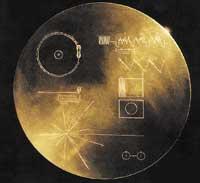
Sagan knew that thousands of years will pass before the Voyager reaches a planetary system like ours, and that only if there are advanced civilizations wanting to investigate space in the universe will the message be taken away, but he believes it was worth throwing the bottle into the sea. Pioneer ships carried a metal plate explaining when and where they formed, but wanted to do something more with Voyager. However, they also have information about the location of the Earth recorded on the album cover.
However, some could not see with good eyes this indifferent strategic information about human beings. What if the ships fell into the hands of a civilization ready to destroy us? Nobel laureate and astronomer Martín Ryle wrote to Sagan a letter full of anguish. “What we know so far is that any evil being who may be out there is able to attack us or eat us as soon as we know each other...” Many others who were not as wise as Ryle showed the same concerns, but, for better or for worse, we have long been reporting on us. Television signals, for example, can be intercepted at a great distance with detectors such as those used on Earth.
Giant gaseous planets
Jupiter, Saturn, Uranus and Neptune are known as gas giants for their enormous size compared to other planets in the Solar System and for having no solid surfaces. From outside to the center everything is gas, yes, as we get denser to the center. The nucleus of these planets is considered to consist of liquid hydrogen that behaves like metal. In general, they are of high volume and low density, with numerous rings and satellites and complex atmospheres. Hydrogen, helium, methane and ammonia are the main components of these planets
A.
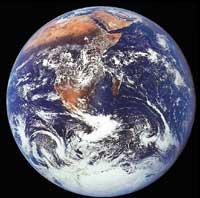
Earth
Distance to the Sun: 150 million km in diameter: 12.756 km Density: 5.52 g/cm 3 Number of satellites: 1 Main features
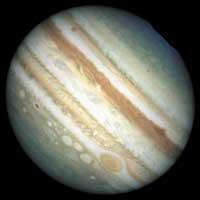
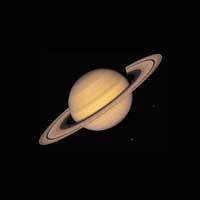
Jupiter
Distance to the Sun: 797 million km in diameter: 142.984 km Density: 1.33 g/cm 3 Number of satellites: 39 Main features: It is the largest planet in the solar system, has an extremely powerful magnetic field and very strong storms. The best known is the red spot. This giant oval shaped storm is the same as two Earth planets.
Saturn
Distance to the Sun: 1,493 million km in diameter: 120.536 km Density: 0.70 g/cm 3 Number of satellites: 30 Main features: It is the brightest planet in the Solar System, with the most spectacular rings. Being less dense than water, if placed in a giant pool, it would float.
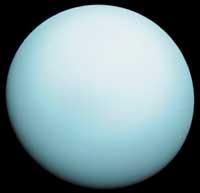
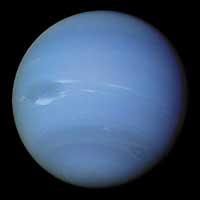
Uranus
Distance to the Sun: 2.942 million km in diameter: 51.118 km Density: 1.30 g/cm 3 Number of satellites: 21 Main features: It was discovered in 1781. Until then astronomers had not realized that there could be planets that were not seen. It has a very curious rotation. Seen from the Sun, it seems lying when turning on one side.
Neptune
Distance to the Sun: 4.125 million km in diameter: 55.528 km Density: 1.76 g/cm 3 Number of satellites: 8 Main features: It was discovered in 1846 and as Pluto has a very special orbit, for some years it is the last planet of the solar system. The methane in the atmosphere absorbs all the red light, by its blue color, and by having another ‘coloring’ that is not yet known.

Gai honi buruzko eduki gehiago
Elhuyarrek garatutako teknologia



